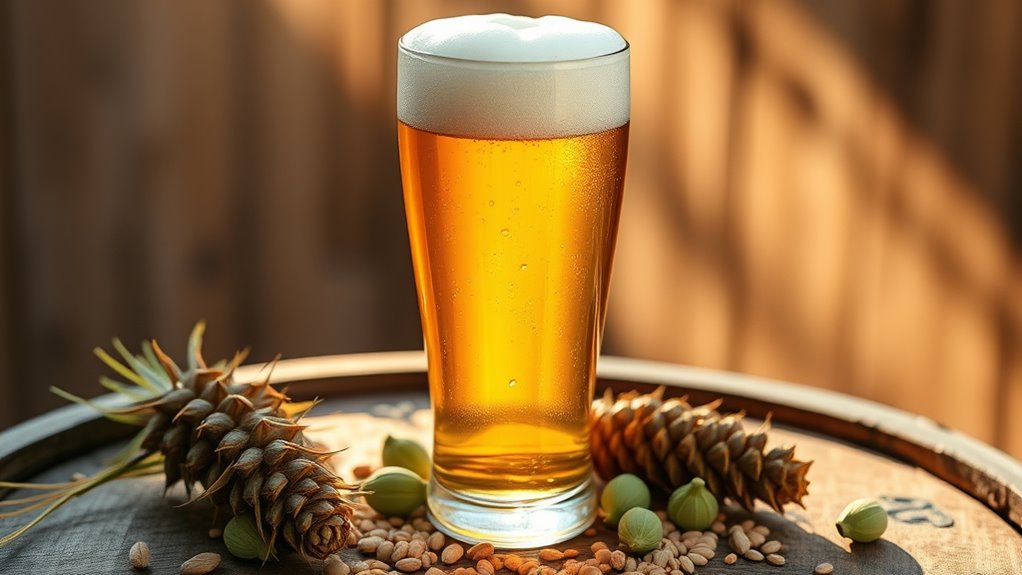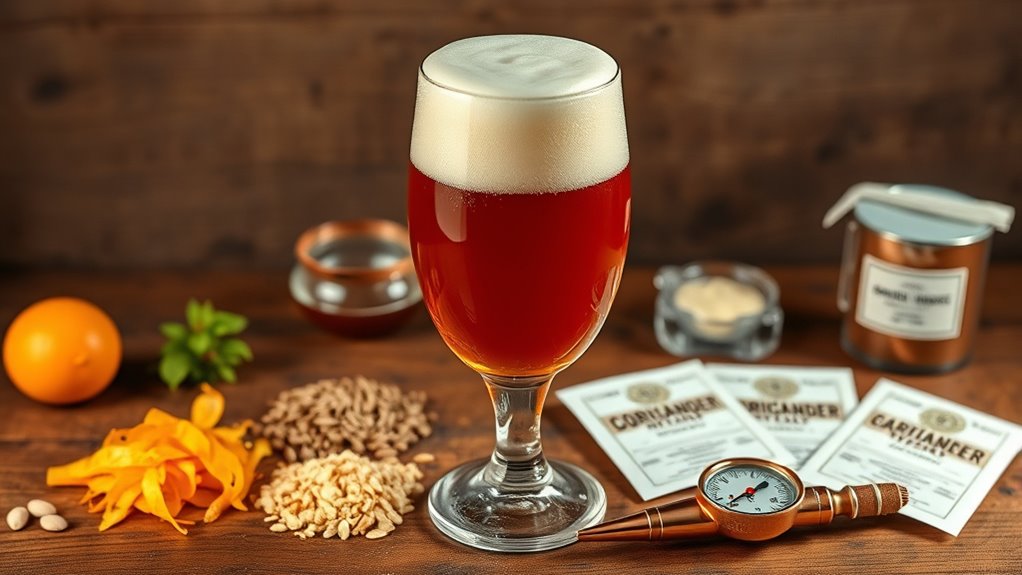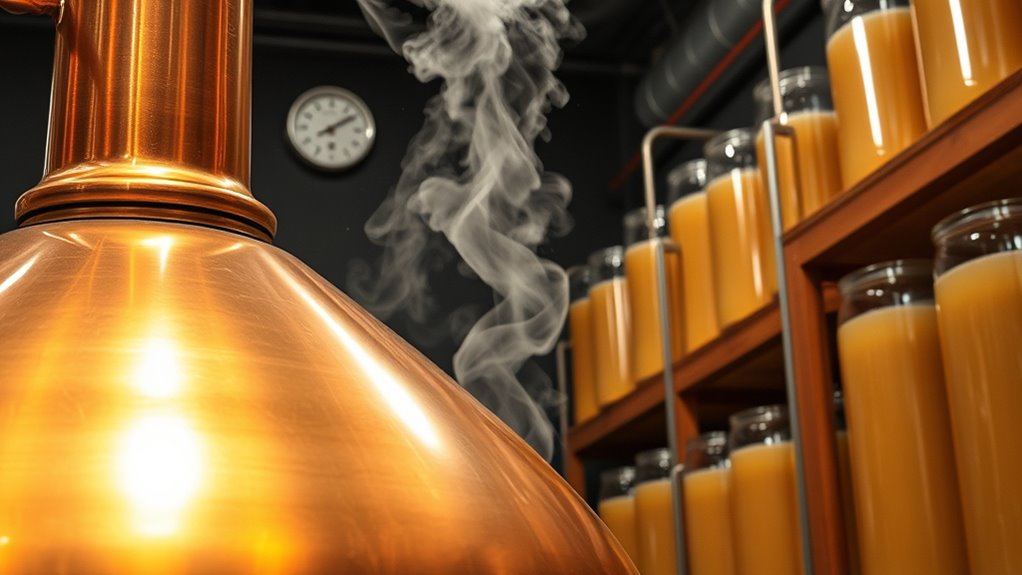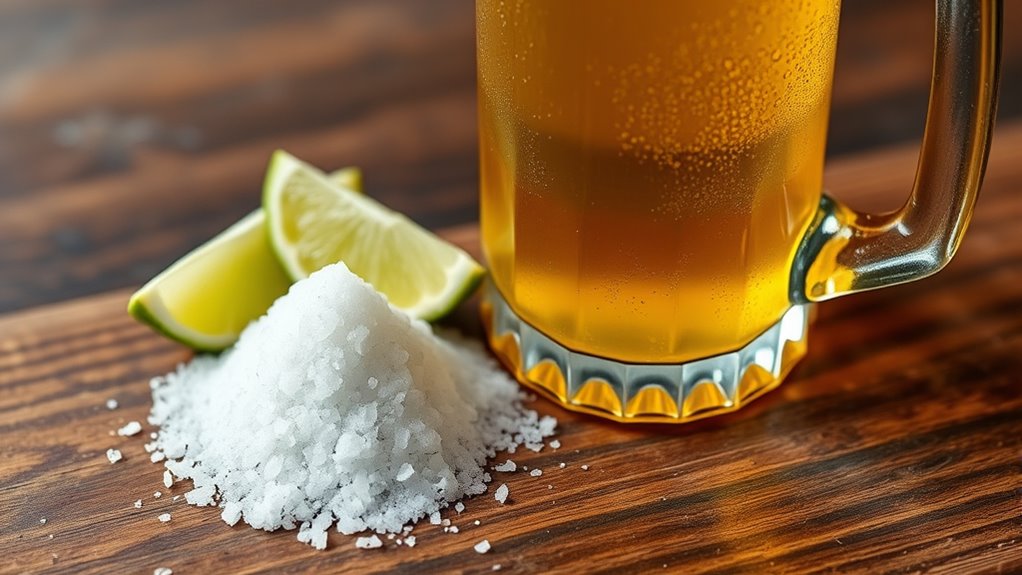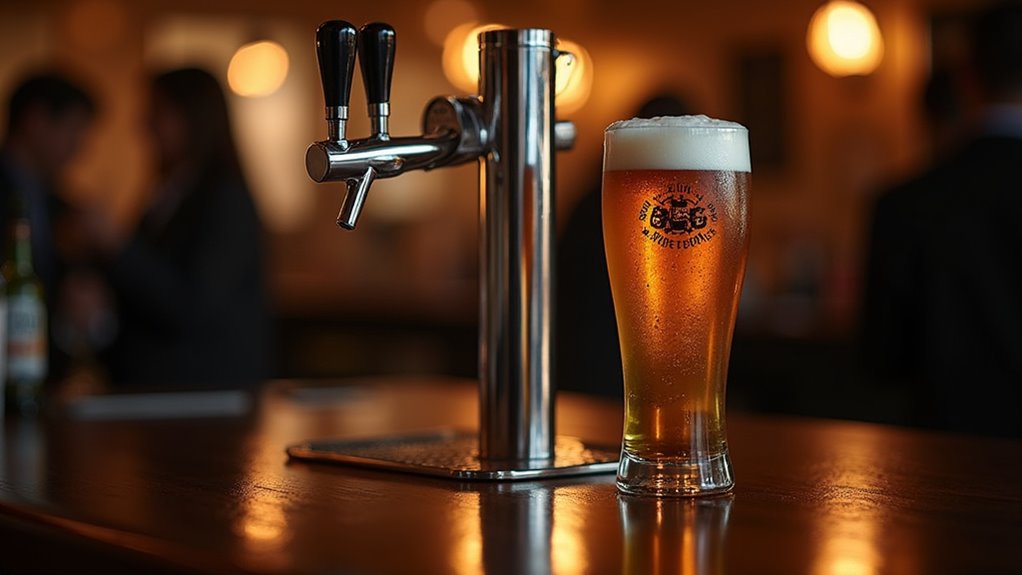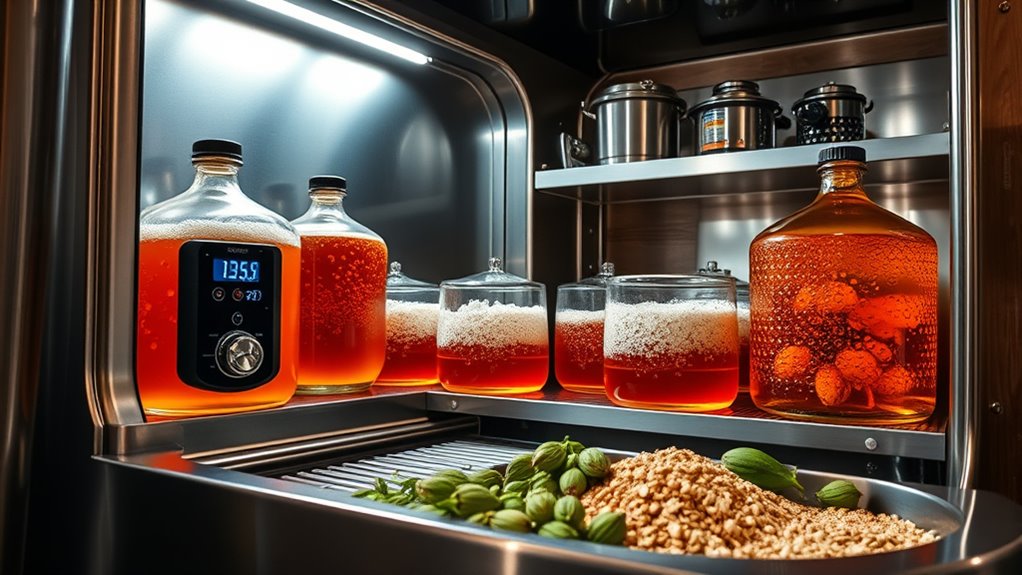To brew an authentic American IPA, start with 70% US 2-Row Malt and 1-2 pounds of Crystal Malt for a clean malt profile. Use US hops like Cascade or Citra for a strong bitterness, targeting 40-70 IBUs. Ferment with a classic American yeast like Safale US-05 at 65-70°F. Be sure to dry hop after primary fermentation for enhanced aroma. Follow these steps carefully, and you’ll create an IPA that showcases vibrant flavors and aromas. More tips can enhance your brewing experience.
At a Glance
- Use a grain bill of 70% US 2-Row Malt combined with 1-2 pounds of Crystal Malt for balanced sweetness.
- Select US-grown hop varieties like Cascade or Citra, adding 1-2 ounces for boil and dry hopping.
- Ferment with Safale US-05 yeast at 65-70°F, ideally around 68°F, to enhance hop character.
- Maintain a sulfate-to-chloride water ratio of 2:1 to boost bitterness and flavor.
- Serve at 45-55°F in a tulip or pint glass for optimal aroma and mouthfeel.
Understanding the American IPA Style
When you plunge into the world of American IPAs, you’ll quickly notice their distinct characteristics that set them apart from other beer styles.
These beers are defined by a robust hop profile, bringing intense bitterness ranging from 40 to over 70 IBUs. You’ll find a clean malt character, primarily from pale ale malts, which allows the hop varieties—like Cascade and Citra—to shine through with vibrant citrus aromas.
The use of specialty malts is minimal, ensuring balance. Pay attention to fermentation temperature and brewing water, as both greatly influence the final product. Understanding these elements is essential for brewing an authentic American IPA. Additionally, selecting the right yeast strains can significantly enhance the hop character and overall flavor profile of your brew.
Key Ingredients for Brewing American IPA
To brew a successful American IPA, you’ll need to focus on four key ingredients: malt, hops, yeast, and water.
- Malt: Use 70% well-modified US 2-Row Malt, adding 1-2 pounds of Crystal Malt for color and flavor. Additionally, consider using Golden Promise as it provides malt complexity that complements bold hop profiles.
- Hops: Incorporate US-grown varieties like Cascade, Centennial, or Citra, using 1-2 ounces during the boil and for dry hopping to achieve robust flavor and bitterness.
- Yeast: Opt for classic American ale strains like Safale US-05, fermenting at 65-70°F for a clean profile.
- Water: A sulfate-to-chloride ratio of 2:1 enhances bitterness and flavor in your IPA.
The Brewing Process for American IPA
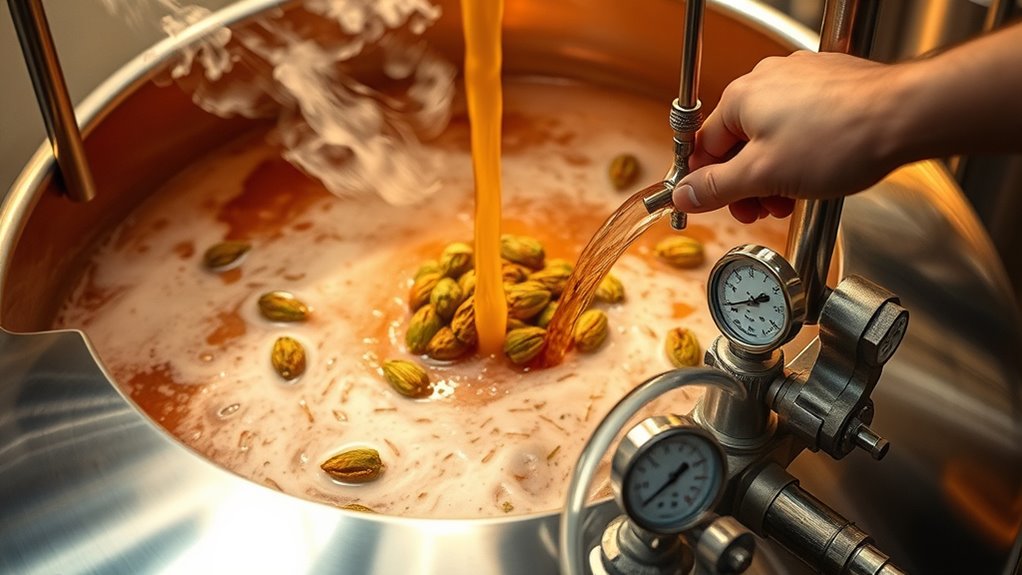
Brewing an American IPA involves several key steps that require attention to detail and careful execution.
Start with a grain bill of 70% well-modified US 2-Row Malt and 1-2 pounds of Crystal Malt. Use a single infusion mash at 149-154°F for ideal sugar extraction. Incorporating step mashing temperatures can enhance the flavor complexity and body of your IPA.
Begin your brew with 70% US 2-Row Malt and 1-2 pounds of Crystal Malt, mashing at 149-154°F for optimal sugar extraction.
Boil your wort in the boil kettle for 60-90 minutes, making hop additions to achieve 40-70 IBUs.
Ferment with a classic yeast strain like Safale US-05 at 65-70°F. After about seven days, transfer to a fermentation vessel for dry hopping.
Finally, carbonate your beer to 2-2.5 volumes of CO2 for a balanced mouthfeel.
Fermentation Techniques for Optimal Flavor
Fermentation is a crucial stage in brewing an American IPA, as it greatly influences the final flavor profile of your beer. To achieve a clean fermentation character, maintain fermentation temperatures between 65–70 °F, ideally around 68 °F.
Primary fermentation lasts about seven days; then, transfer the beer to a secondary fermenter for dry hopping. Using a classic American ale yeast like Safale US-05 enhances hop aroma, allowing flavors to shine.
Gradually increasing temperature during fermentation can improve attenuation while minimizing undesirable compounds. Effective temperature management is essential to avoid issues such as yeast stress or stalled fermentation.
Helpful Hints:
- Monitor temperatures closely.
- Dry hop on day three for best results.
Achieving the Perfect Hop Profile
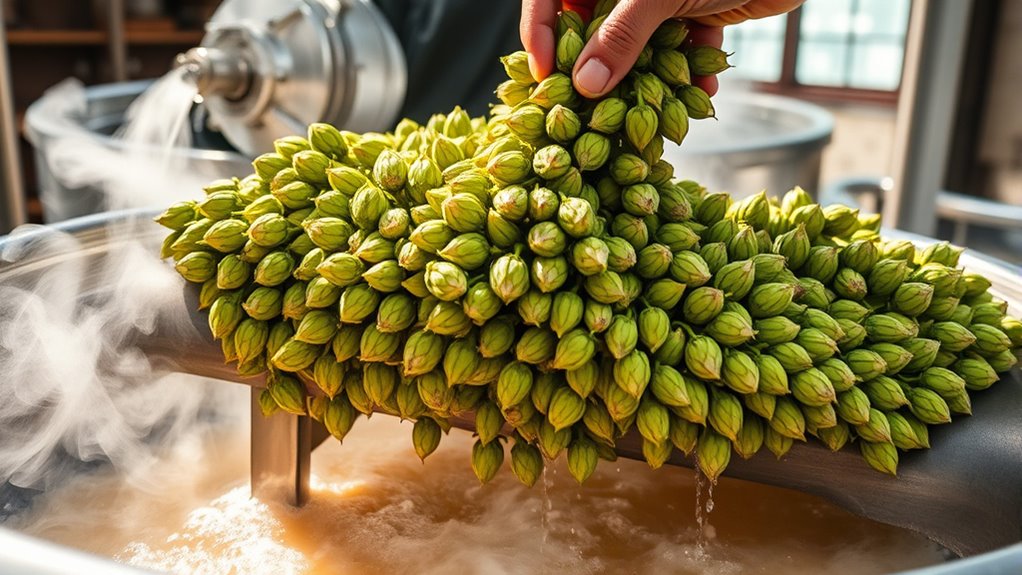
Achieving the ideal hop profile in your American IPA requires careful selection and timing of hop additions, which ultimately impacts both flavor and aroma.
Use US-grown varieties like Cascade, Centennial, and Citra, aiming for 1-2 ounces per bittering, flavor, and aroma addition during the boil. Target an IBU range of 40-70 for balanced bitterness.
Select US-grown hops like Cascade, Centennial, and Citra, aiming for 1-2 ounces per addition to achieve balanced bitterness in your American IPA.
Incorporate multiple late hop additions, totaling 2-4 ounces, to enhance complexity. For best hop flavor, dry hop with 1-2 ounces of hop pellets in the secondary fermenter for a week at 68°F. Hop utilization percentage is crucial to ensure you achieve the desired bitterness levels.
Adjust your water profile to feature a higher sulfate-to-chloride ratio for crisp bitterness.
Helpful Hints
- Experiment with different hop varieties.
- Monitor your IBU for balanced flavor.
- Consider water chemistry for desired outcomes.
Tips for Serving and Enjoying American IPA
How can you enhance your enjoyment of American IPA? Start by serving it at a temperature between 45-55°F (7-13°C) to maximize hop aroma and flavors while keeping it invigorating.
Use a tulip or pint glass to allow proper aeration, enhancing your drinking experience. Aim for a carbonation level of 2 to 2.5 volumes of CO2, which improves mouthfeel and hop perception.
Allow your beer to warm slightly in the glass; this reveals complex notes often masked when too cold. Finally, consume your American IPAs fresh, ideally within weeks of packaging, to savor vibrant flavors and aromas.
Helpful Hints:
- Serve cold but not too cold.
- Choose the right glass.
- Check carbonation levels.
- Let it warm up.
- Drink fresh.
